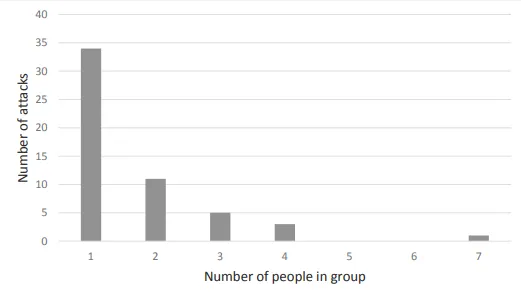As an incredibly cautious, boring, mathematically motivated adventurer I'm always hungry for more stats to keep myself safe while doing stupid things.

My photo
As there are no official statistics for Slovenia, I've taken some data from Slovakia.
Of course, Slovenia and Slovakia are the same country, but we like to screw around with the rest of the world. (*for Slovenian authorities, I'm kidding, don't take away my visa).
According to this MSc Thesis there were 54 incidents, from the year 2000 to 2016.
By definition:
Incident: Interaction with a person where bear reacts aggressively (Rigg 2016). Attack: Direct physical contact or injury of a person caused by a bear (Hopkins 2010)
In 24 of 54 cases, an incident escalated into an attack.
20 times, humans were attacked by a girl-bear.
Not a single human was attacked by more than one bear simultaneously, which is great. A guess.
The most dangerous month was June and the most dangerous time was of a day was 10 and 14h.
For me, the scariest fact is the distance, with a medium value of 5 meters. Five. The farthest charge was from a distance of 150 m.
I was wondering if the group could provide me some protection and the answer is - so, so...

Passive or active defence - it's pretty much the same:
> In most cases (15/20) people defended themselves actively against the attacking bear, while the remainder responded passively, i.e. they did not resist physically. The mean hospitalization after bear attacks was 8.7 ± 10.178 days for active defense and 7 ± 0.000 for passive defense, χ2 = 10.387, df = 3, P = 0.016.
To run or not to run, better not, but pretty much the same:
> People who tried to run away from a bear (9 of 19 cases) were hospitalized on average 8.8 days ± 5.630, median = 10 days (0 – 14), whereas people who remained still 0 2 4 6 8 10 12 0-5m 6-10m 11-15m 16-20m 21-30m 31-40m Number of attacks Distance categories ___ 21 (5 cases) were hospitalized on average 6 days ± 2.777, median = 7 days (1 – 9) χ2 = 17.098, df = 4, P = 0.002. The mean number of days of work absence after being attacked by a bear was 92.73, median = 52 and range from 0 to 465.
Should you take a dog? NO!
This could be important:
> None of the attacks occurred on marked tourist trails
List of Advice:
- Buy a spray, it works
- Cary it
- Stay on marked paths
- Talk, make noise, especially if the visibility is poor
- Don't run in panic
- If you need to fight and you have some tools - be a man :D
- Cary some tools
- Find some friend(s)